Individual environmental regulations
The JEOL Group conducts its business activities while complying with environmental regulations such as the “EU RoHS Directive”, “EU Battery Directive”, and “China RoHS”. We require our suppliers to comply with these regulations as well.
EU RoHS Directive
1. Date of Compliance
-
The JEOL Group has been providing instrument that comply with the European RoHS Directive, a directive that limits 6 harmful substances to be used in making electrical and electronic products since July 22, 2017.
-
The Official Journal (2015/863/EU) was promulgated on June 4, 2015, adding four phthalate esters (DEHP/BBP/DBP/DIBP) as prohibited substances to this revised RoHS Directive.
[Effective Date of Enforcement]
Cat.1-7,10,11
: July 22, 2019
Cat.8,9
: July 22, 2021 ・・・Our products are applicable
2. JEOL Group RoHS Compliance Policy
-
Catalog items (commercially available standard products) and purchased items with specifications
We request that suppliers submit a Certificate of Non-Use of RoHS Designated Substances, etc. for each JEOL Group P/N. -
Products manufactured by using drawing prepared by the JEOL Group
(a)Material: all non-RoHS compliant materials will be eliminated (excluding exception).
(b)Secondary treatment: all secondary treatment instruction for RoHS non-compliance will be eliminated.
(c)Supplementary materials (sub-materials): The JEOL Group will provide a list of supplementary materials, from which suppliers are requested to select. -
In the event that instruction by drawing is not appropriate, we will issue a notice to ask the supplier to respond to it.
3. RoHS Compliance Judgement
-
The RoHS compliance of the supplier will be judged by the Certificate of Non-Use of RoHS Designated Substances submitted by them. For details, please refer to the attached: Analysis of Chemical Substance of Purchased Material.
-
Analysis Requested in Other Formats
JEOL may ask for survey in different formats for faster survey. We appreciate your cooperation.
4. RoHS Restricted Substances
RoHS designated substances for inclusion *1 are listed below.
| No | Name of Chemical Substance Group | Allowable Concentration*2 | Note |
|---|---|---|---|
| 1 | Lead and its compounds | 1000 ppm | |
| 2 | Mercury and its compounds | 1000 ppm | |
| 3 | Cadmium and its compounds | 100 ppm | |
| 4 | Hexavalent chromium | 1000 ppm | |
| 5 | Polybrominated biphenyls (PBBs) | 1000 ppm | |
| 6 | Polybrominated diphenyl ethers (PBDEs) | 1000 ppm | |
| 7 | Bis(2-ethylhexyl)phthalate(DEHP) | 1000 ppm | CAS No.117-81-7 |
| 8 | Butyl benzyl phthalate(BBP) | 1000 ppm | CAS No.85-68-7 |
| 9 | Dibutyl phthalate(DBP) | 1000 ppm | CAS No.84-74-2 |
| 10 | Diisobutyl phthalate(DIBP) | 1000 ppm | CAS No.84-69-5 |
Please check the latest information on the web site of public organization as exemptions change from time to time.
*1 Inclusion: This term refers to the presence of chemical substances in raw materials, parts, and units as components or contents. Naturally occurring chemical substances (impurities) and those that remain in general industrial refining stages (impurities and residues) are regarded as not included if there is no technically predictable value or no information on the amount contained, except in cases where their inclusion would cause problems under domestic or foreign laws and regulations. However, even if the substance is included as an impurity, if it is clear that the concentration exceeds the allowable concentration, it is considered to be included.
*2 Allowable concentration: Concentration in homogeneous material. Therefore, the allowable concentration for a composite part is not the concentration per part, but the concentration in each component material of the part.
Component materials
1. Example of Zn Plating

2. Example of Electrolytic Capacitor

EU Battery Directive
Please take the following actions in response to the EU Battery Directive.
Requirements for batteries (all batteries, including storage batteries)
All batteries, devices, and units, whether primary or secondary, and whether stand-alone or incorporated in equipment or units, shall satisfy the requirements for batteries in [Appendix Table] (excluded from the RoHS Directive and separately required by the Battery Directive).
For parts other than battery cells in assembled battery, etc., the requirements in [Appendix 2] shall be satisfied.
【Appendix】Basic Requirements on Batteries
1. Restricted Substance Contained in Batteries
| Substance Name | Target of Regulation | Maximum allowable concentration (*1) | Based on EU directive |
|---|---|---|---|
| Cadmium and its Compounds | Cadmium contained in mobile batteries or rechargeable batteries | 0.002 weight%(20 ppm) | 2006/66/EC |
| Mercury and its Compounds | Mercury in all batteries except button battery | 0.0005 weight %(5 ppm) | |
| Mercury contained in button battery | 2 weight %(20000 ppm) |
2. Requirements in case batteries are incorporated into equipment or units
| Required Object | Requirements |
|---|---|
| Method of incorporation | Batteries that are incorporated into equipment or units can be easily removed. |
| Description in instruction manual | An instruction manual or similar documents on how to safely remove the incorporated batteries must be attached. |
China RoHS
We conduct following practices for products to be shipped to China, in order to comply with “China RoHS” that was enforced on March 1, 2007.
Provision of the list of contained chemical substances in the packing (clear writing of parts containing chemical substances and the name of substances)
Attachment of labels (labels indicating environmental protection expiration dates)
Indication of packing materials on the packing box
